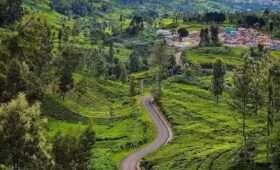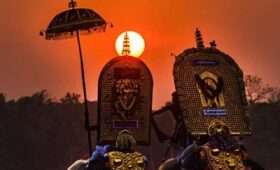If we were meant to stay in one place, we’d have roots instead of feet !!
Tamil Nadu is a stunning combination of sophisticated cities, peaceful beaches, and temple towns that is brimming with culture and wonderful history. Tamil Nadu, sometimes known as the “country of temples,” is one of India’s most well-liked tourist sites and sees a lot of visitors each year. From its waterfalls to its famous temples, Tamil Nadu is a stunning region to discover in India.
You should consider visiting some of Tamil Nadu’s most well-known temples if spiritual travel is what motivates you. Even though Chennai is home to many temples, you should thoroughly review the list of Tamil Nadu temples before visiting. The temples of Tamil Nadu won’t simply calm you with their peace and tranquillity; their incredible architectural beauty and sculptures will wow you.
The most incredible time to visit Tamil Nadu is during the winter, specifically between November and February when the weather is generally mild and it is enjoyable to explore the state’s well-known tourist sites is enjoyable. The intense rains brought on by Tamil Nadu’s monsoon season render it unsuitable for travel and exploration.
Meenakshi Amman Temple in Madurai
Meenakshi, another name for Goddess Parvati, is worshipped at this temple together with Lord Shiva, who is represented by Lord Sundareshwarar. The Meenakshi Amman Temple is one of the oldest and most well-known temples in India, not only in Tamil Nadu. It is dedicated to Goddess Parvati, who appears as Meenakshi, and her husband, Lord Shiva, who appears as Lord Sundareswarar. The temple was established in the sixth century AD, according to historical and archaeological data, and the Muslim conquerors in India severely ruined the majority of it in the fourteenth century. When the Nayak kings once more rebuilt the temple to its original splendour in the 16th century, the current building was built.
Brihadeeswarar Temple in Thanjavur
In Tamil Nadu’s Thanjavur district lies the beautiful home of Lord Shiva known as the “Brihadeeswarar Temple.” One of India’s biggest temples is this one. Another renowned Shiva temple in Tamil Nadu is called Brihadeeswarar or Brihadisvara. In the eleventh century AD, the Chola Dynasty constructed it. One of the Great Living Chola Temples in India, the temple is situated in the Thanjavur district and is a UNESCO World Heritage Site. Along with its impressive construction, the temple complex’s 216-foot-tall Vimana and its 80-ton Kumban draw tourists eager to learn about notable architectural feats from Indian history. Every day, thousands of worshippers come to this well-known Shiva temple in Tamil Nadu.
Sri Ranganathaswamy Temple in Srirangam
The “Ranganathaswamy Temple,” which is dedicated to Lord Vishnu and is situated on the Srirangam Island in the Tamilnadu city of Tiruchirappalli, is yet another example of Dravidian architecture at its finest. The temple, which is spread out over 150 acres, includes 49 sub-shrines and 21 exquisitely carved Gopurams (tower entrances), the highest Gopuram in Asia at 236 feet. The temple also contains 21 more sub-shrines. The temple also contains seven enclosures, or prakaras, with the main deity of Lord Vishnu—Lord Ranganathaswamy—preserved in the innermost prakara and resting on a snake with five heads. A tower in the shape of “Om” that is entirely covered in gold is located above the innermost prakara.
Ramanathaswamy Temple Rameshwaram
A sacred Hindu pilgrimage destination, the Ramanathaswamy Temple in Rameshwaram is one of the 12 Jyotirlinga temples. The name Ramanathaswamy is thought to have been derived from Lord Rama, who is said to have erected and worshipped the Shiva Lingam located at the temple before crossing the bridge to Lanka. For the transgressions he would do while fighting Ravana, Lord Ram wished to beg his lord’s pardon. A Lingam from the Himalayas will be brought, which he asked Hanuman to bring. Nevertheless, Lord Ram chose to construct a Lingam out of the sand, which is put before the sanctuary, due to his tardy entrance. The temple is home to the Vishwalingam, another lingam carried from Kailash.
Jambukeswarar Temple Thiruvanaikaval
The “Jambukeshwara Temple,” a shrine to Lord Shiva, is situated on the Tamilnadu island of Srirangam. This temple, which was constructed during the Chola era, is an outstanding illustration of Dravidian architecture. Its seven-tiered Gopurams are decorated with intricate sculptures that show off the aesthetic splendour of the Chola Kingdom. Shiva Lingam is a water lingam known as an app lingam, and beneath the Shivling, a torrent of water continually spews forth. Under the “Jambu Tree,” which is thought to have arisen from the head of a meditating saint, Goddess Parvati in the shape of Akilandeswari carried out a severe penance. She created a lingam out of the River Cauvery’s flowing water to perform the Pooja. Shiva offered her darshan and taught her the Shiva Gnana after being moved by Parvati’s devotion.
Ekambareswarar Temple in Kanchipuram
Lord Shiva is the subject of several well-known temples in Tamil Nadu. In Kanchipuram, one of these is the Ekambareswarar Temple. It represents the element Earth and is renowned as one of the Pancha Bhoota Sthalas. People come to the temple to worship Lord Shiva, also known as Ekambareswarar or Ekambaranathar, in the shape of an idol Prithvi Lingam, and a Lingam. According to legend, in this location, beneath a mango tree, Goddess Parvati used to worship Lord Shiva in the shape of a Prithvi Lingam (a Shiva Lingam built of sand). The Lord was moved by this act of kindness and manifested himself to wed the Goddess.
Kapaleeshwarar Temple in Chennai
This temple may be found in the Mylapore neighbourhood of Chennai, Tamil Nadu. During the rule of the Pallava King in the seventh century CE, it was constructed. The present-day Kapaleeshwarar Temple construction was repaired by the Vijayanagara Kings in the 16th century after the Portuguese had demolished the old building. The temple, which is devoted to Lord Shiva, is one of the well-known pilgrimage attractions that draw visitors from around the nation. Legend has it that Goddess Parvati visited the location and, in the shape of Mayil, gave Lord Shiva a significant penance. Under the Punnai tree in the temple complex is a modest shrine to the Goddess that tells her tale and is in the shape of a peahen.



